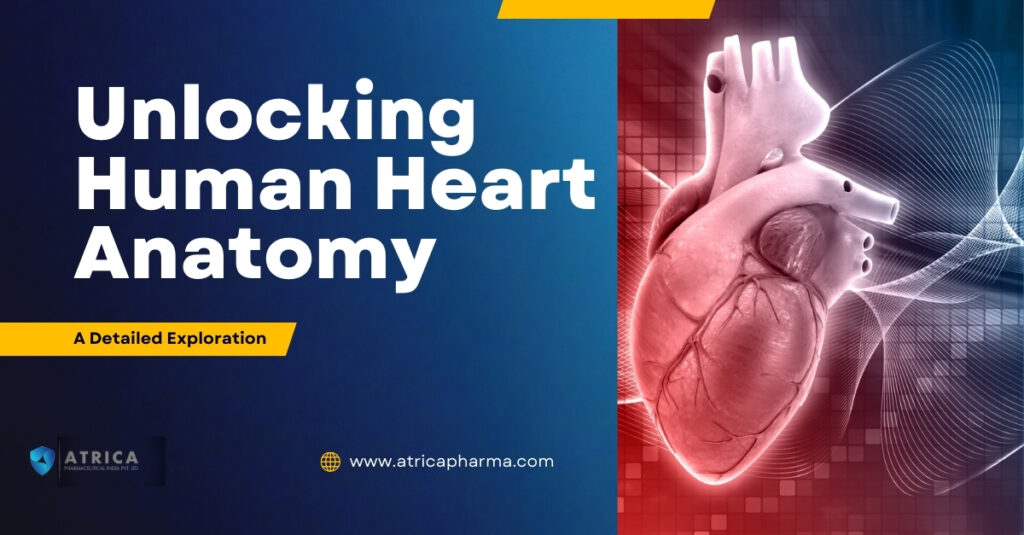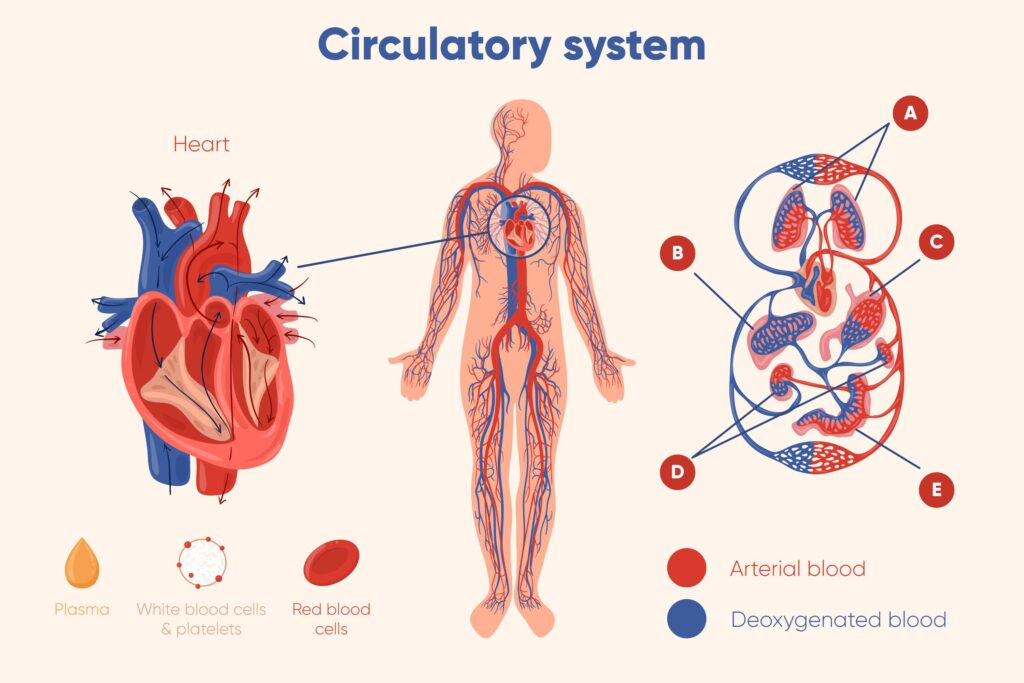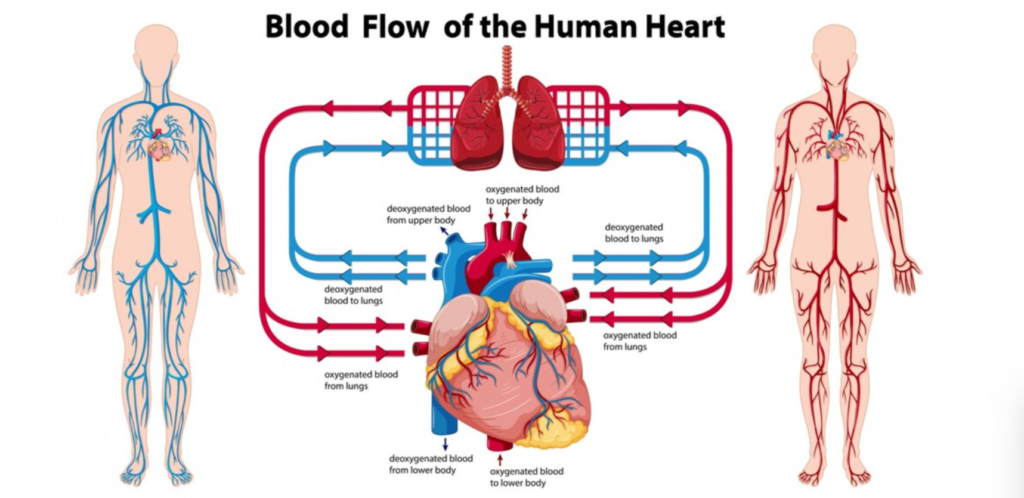
Unlocking Human Heart Anatomy: A Detailed Exploration
Human Heart Anatomy: The human heart, an extraordinary organ that orchestrates the symphony of life, lies nestled within the chest, steadfastly pulsating to sustain our existence. This integral component of the circulatory system not only powers the delivery of life-sustaining oxygen but also serves as a testament to the complexity of biological engineering.
In this exploration, we embark on a journey to unravel the mystique of the human heart, understanding its anatomical intricacies and the profound significance it holds in the tapestry of human physiology.
Anatomy of the Human Heart

Location and Positioning: Human Heart Anatomy
The heart, a resilient muscle, finds its abode in the thoracic cavity, slightly left of the midline. Sheltered by the protective embrace of the ribcage, this positioning optimizes the heart’s efficiency in pumping blood to every corner of the body.
Size and Shape: Human Heart Anatomy
Poetically described as the size of a clenched fist, the heart assumes a conical shape. Dynamic in its nature, the heart’s dimensions may subtly vary based on factors such as age, gender, and overall health.
Pericardium: Human Heart Anatomy
The heart is ensconced in a dual-layered pericardium, a protective sac that ensures smooth, frictionless contractions. This sac not only shields the heart but also facilitates its rhythmic dance within the chest cavity.
Chambers of the Heart: Human Heart Anatomy
A masterful design, the heart comprises four chambers – two atria and two ventricles. The right atrium welcomes deoxygenated blood, while the left atrium hosts its oxygenated counterpart. Coordinated contractions of the ventricles propel blood to the lungs and throughout the body.
Valves: Human Heart Anatomy
The heart’s valves, gatekeepers of circulatory order, include the tricuspid and mitral valves regulating atrioventricular flow, and the pulmonary and aortic valves governing blood exit. This orchestrated valve symphony ensures unidirectional blood flow, a cornerstone of efficient circulation.
Circulatory Pathways – Human Heart Anatomy

The heart’s rhythmic contractions set the stage for a grand spectacle of blood circulation, orchestrating a ballet that ensures the delivery of oxygen and nutrients to every tissue and the removal of waste products. Divided into two primary pathways – pulmonary and systemic circulation – the circulatory system epitomizes efficiency and precision.
Pulmonary Circulation:
The journey begins as deoxygenated blood, laden with carbon dioxide, returns from the body to the right atrium. This reservoir contracts, propelling the blood through the tricuspid valve into the right ventricle. With each powerful beat, the right ventricle pumps the blood through the pulmonary valve into the pulmonary artery, which carries it to the lungs.
Within the intricate pulmonary capillaries, a crucial exchange occurs – carbon dioxide is expelled, and oxygen is absorbed. The freshly oxygenated blood then returns to the heart via the pulmonary veins, entering the left atrium to commence the next phase of its journey.
Systemic Circulation:
Oxygenated blood, now enriched with life-sustaining oxygen, awaits its cue in the left atrium. As the left atrium contracts, the blood passes through the mitral valve into the left ventricle. The left ventricle, a muscular powerhouse, propels the oxygenated blood through the aortic valve into the aorta – the body’s largest artery.
From the aorta, a network of arteries branches out, distributing the oxygenated blood to organs, tissues, and cells throughout the body. As the blood traverses the capillaries, nutrients are delivered, waste products are collected, and the deoxygenated blood begins its return journey to the heart through the veins. This cycle, a continuous ebb, and flow, sustains the intricate balance required for life.
Understanding these circulatory pathways unveils the intricacies of the heart’s role not only as a pump but as a conductor in the symphony of life. The precision with which blood shuttles between the heart, lungs, and the entire body underscores the remarkable efficiency of this vital organ. As we navigate the pathways of the circulatory system, the sheer elegance of this biological dance becomes increasingly apparent, emphasizing the interconnectedness of every heartbeat to the rhythm of life.
Blood Supply to the Heart – Human Heart Anatomy

Coronary Arteries:
The heart, despite its tireless duty, requires sustenance. Enter the coronary arteries, branches of the aorta tasked with delivering a continuous stream of oxygenated blood to the heart muscle. This intricate network ensures that the heart, the very architect of circulation, remains nourished.
In the intricate dance of blood and beats, the heart emerges not only as an anatomical marvel but as the epicenter of vitality itself. Understanding its form and function allows us to appreciate the poetry in its pulsations, reminding us of the delicate balance that sustains life.
FAQs – Human Heart Anatomy
Q1: What is the normal heart rate?
A1: The average resting heart rate for adults ranges from 60 to 100 beats per minute.
Q2: How does the heart regulate its rhythm?
A2: The heart’s rhythm is controlled by a natural pacemaker called the sinoatrial (SA) node, located in the right atrium.
Q3: Can the heart repair itself after injury?
A3: Unlike some organs, the heart has limited regenerative capabilities. Scar tissue often forms after injury, affecting its overall function.
Q4: What is a heart attack, and how does it occur?
A4: A heart attack, or myocardial infarction, happens when blood flow to a part of the heart muscle is blocked, usually due to a blood clot.
Q5: How can one maintain a healthy heart?
A5: Adopting a balanced diet, regular exercise, avoiding smoking, and managing stress contribute to healthy heart.
Q6: What is the significance of cholesterol in heart health?
A6: Cholesterol is essential for various bodily functions, but high levels can contribute to the development of atherosclerosis, narrowing the arteries and increasing the risk of heart disease.
Q7: Are congenital heart defects common?
A7: Congenital heart defects are relatively common and may range from minor issues to severe malformations requiring surgical intervention.
Q8: What is heart failure?
A8: Heart failure occurs when the heart cannot pump enough blood to meet the body’s needs, leading to symptoms like fatigue, shortness of breath, and fluid retention.
Q9: Can emotional stress impact heart health?
A9: Chronic stress can contribute to heart problems by affecting blood pressure, promoting unhealthy habits, and triggering inflammation.
Q10: How is heart health assessed?
A10: Doctors may assess heart health through various tests, including electrocardiograms (ECGs or EKGs), echocardiograms, and stress tests.
Conclusion – Human Heart Anatomy
Human Heart Anatomy: Delving into the intricate details of human heart anatomy unveils the sophistication of this vital organ. From its precise positioning within the chest cavity to the orchestrated dance of chambers and valves, every aspect plays a crucial role in maintaining life. Understanding the anatomy of the human heart not only fosters appreciation for its complexity but also underscores the importance of adopting a heart-healthy lifestyle to ensure its optimal function for years to come.
Thanks for posting. I really enjoyed reading it, especially because it addressed my problem. It helped me a lot and I hope it will help others too.
Thank you for your help and this post. It’s been great.
Your articles are very helpful to me. May I request more information?
Thank you for writing this post. I like the subject too.
Sustain the excellent work and producing in the group!
It really a great and useful piece of information. I am glad that you shared this helpful info with us. Please keep us informed like this. Thank you for sharing.
We’re a bunch of volunteers and starting a brand new scheme in our community. Your web site provided us with helpful info to paintings on. You have performed an impressive task and our entire neighborhood might be grateful to you.